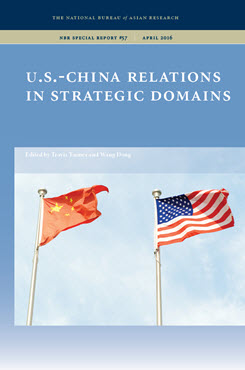Conclusion
U.S.-China Relations in Strategic Domains
This is the conclusion to the report “U.S.-China Relations in Strategic Domains.”
The rise of the People’s Republic of China is one of the most consequential developments in the Asia-Pacific, and growing uncertainties about the future of U.S.-China relations make this study particularly timely. Taken together, the essays in this report offer a fresh approach to addressing areas in the bilateral relationship where the two sides currently do not see eye to eye—from more established strategic domains, such as maritime and nuclear, to newer ones, such as cyber and space. Given the importance of U.S.-China relations, the report underscores the need to make progress in these domains so that future developments will not destabilize, or derail, the overall relationship. As a baseline, a consensus exists among the authors that, despite the current challenges, there exists room for cooperation in each of the domains studied. Indeed, China’s growing set of strategic interests creates new opportunities, and even incentives, for cooperation. At the same time, China’s expanding international profile raises the costs of escalation, especially if divergences between the United States and China on key issues remain an obstacle to crisis management. This is especially true in the newer domains where there is a relative lack of experience and established norms. Going forward, it may be possible to apply lessons from some domains toward strengthening cooperation in other domains. In the international context, the United States and China are also not the only players in the maritime, nuclear, cyber, and space domains, which heightens the stakes for global security as the two countries blaze their paths forward in these areas.
The challenges in these domains, however, are well documented by the authors. As is evident throughout this report, these domains are sources of friction because both sides’ interests are firmly rooted in broader geopolitical, security, and economic interests. Moreover, these same factors—coupled with disparity in levels of capabilities in some cases—drive U.S. and Chinese perceptions of the other side’s interests, resulting in assumptions and narratives that widen the gap in rhetoric and actions. As such, this report’s inclusion of each country’s perception of the other’s interests in these domains makes a valuable contribution to the understanding of U.S.-China relations by shedding light on why the two sides have difficulty reaching agreement on these issues. Given that a significant change in one country’s position will most certainly alter the calculus of the other, the report’s recommendations underscore an urgency in managing the risks of escalation—whether this is through strengthening frameworks and norms, developing confidence-building measures, or even addressing distrust through a more nuanced understanding of each other’s positions.
Various forms of bilateral engagement on strategic domains could play a role in managing risk and building cooperation. The special studies in this report highlight the potential for exchanges at the people-to-people and military-to-military levels to push forward bilateral discussions. Beyond establishing good habits of engagement, these two modes of exchange can cut across issues in all the strategic domains and tap into the broader policy communities on both sides. More importantly, the outcomes of these discussions can add content and substance to the relationship, setting it on a more durable and constructive course. In this sense, official and nonofficial discussions complement each other in addressing critical issues in the strategic domains.
While challenges in the strategic domains will remain salient in the U.S.-China relationship, the authors identify areas of convergence for fostering cooperation and recommend steps that policymakers can take to manage tensions in areas of divergence. As is evident in this report, the key is not to disregard the areas of disagreement—or let them diminish the possibilities for cooperation—but rather to foster an understanding of each side’s approach in order to talk about these issues more constructively. The future course of the U.S.-China relationship has ramifications both for regional security, even in contingencies not directly involving the two countries, and for the international system as China carves out its global role. Looking ahead, the methodology employed in this report might be useful for understanding areas of convergence and divergence on other substantive issues, including views of global governance, the broader functions of the international system, and the importance of innovation to economic development.
Tiffany Ma is Director of Political and Security Affairs at the National Bureau of Asian Research.


